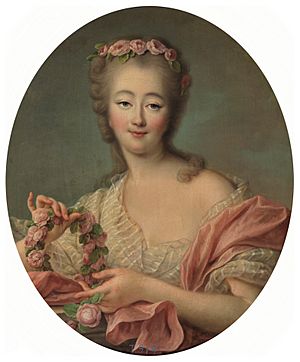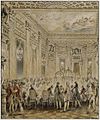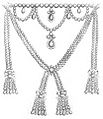Madame du Barry facts for kids
Quick facts for kids
Jeanne Bécu,
Countess of Barry |
|
|---|---|

Madame du Barry
|
|
| Born | 19 August 1743 Vaucouleurs, France
|
| Died | 8 December 1793 (aged 50) |
| Occupation | Official Mistress to Louis XV |
| Spouse(s) | Count Guillaume of Barry |
| Parent(s) | Anne Bécu Jean Baptiste Gormand de Vaubernier |
Jeanne Bécu, also known as Comtesse du Barry (born August 19, 1743 – died December 8, 1793), was a very important friend and companion to King Louis XV of France. She was the last person to hold this special role in the king's life.
During the French Revolution, Jeanne was put to death by guillotine. This was because she was accused of treason, which means going against her country. People thought she was helping others who had left France during the Revolution to escape.
Contents
Life with King Louis XV: 1768–1774
Jeanne became very popular in Paris after King Louis XV showed a lot of interest in her. She wore amazing and very expensive dresses.
In 1772, King Louis XV asked two jewelers in Paris to make a huge and beautiful diamond necklace for Jeanne. It was meant to be more grand than any other necklace ever made. It was estimated to cost about two million livres, which was a lot of money back then.
Even though Jeanne was known for being kind and supporting artists, many people started to dislike her. This was because the king spent so much money on her. She always seemed to be in debt, even with the large amount of money the king gave her every month.
Jeanne stayed in her special position until King Louis XV passed away.
Life After the King: 1774–1792
After King Louis XV died, his grandson became the new king, Louis XVI. The new queen, Marie Antoinette, sent Jeanne away from the royal court. Jeanne was sent to live at the Abbey du Pont-aux-Dames, which was a type of monastery near Meaux-en-Brie.
Arrest and Trial: 1792–1793

Jeanne had a servant named Zamor. He joined some revolutionary groups during the French Revolution. In 1792, Jeanne found out about Zamor's connections to these groups. She asked him about it and then told him he had three days to leave her service.
Zamor left and then reported Jeanne to the revolutionary authorities. He said she was helping people who had left France during the Revolution. Because of Zamor's statements, Madame du Barry was arrested in 1793.
A revolutionary court in Paris accused her of treason. She was found guilty and sentenced to death. She tried to tell them where some hidden jewels were to save herself, but it didn't work.
On December 8, 1793, Madame du Barry was executed by guillotine in a public square called the Place de la Révolution. She was buried in the Madeleine Cemetery. Many other people who were executed during this time, including King Louis XVI and Marie Antoinette, were also buried there.
Gallery
-
Madame du Barry, by Élisabeth-Louise Vigée Le Brun (painted between 1789 and 1805)
-
Jean-Michel Moreau the Younger, Fête donnée à Louveciennes le 2 septembre 1771, Musée du Louvre, Paris
-
Marble bust of Madame du Barry by Augustin Pajou, 1773, National Museum in Warsaw
-
The diamond necklace ordered by Louis XV for Madame du Barry
-
Madame du Barry being taken away to the scaffold, by Tighe Hopkins, The Dungeons of Old Paris, 1897
Images for kids
-
Madame du Barry, by Élisabeth Vigée Le Brun; painted between 1789 and 1805. Vigée Le Brun started this portrait in 1789 but had to stop when she left France during the French Revolution. Later, she finished it and gave it to her niece.
See also
 In Spanish: Madame du Barry para niños
In Spanish: Madame du Barry para niños












